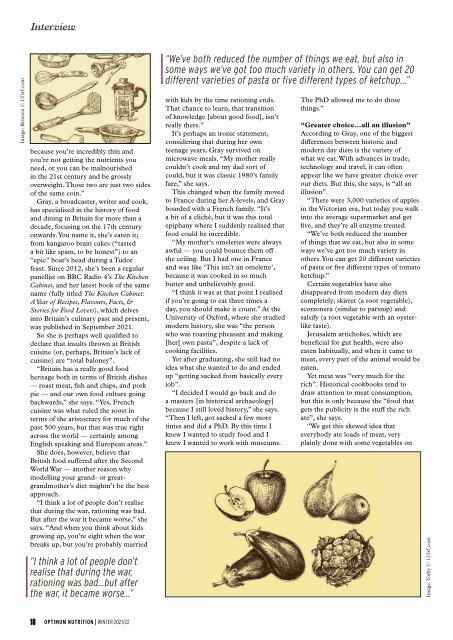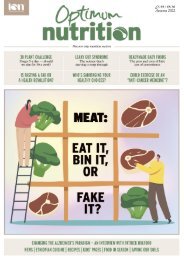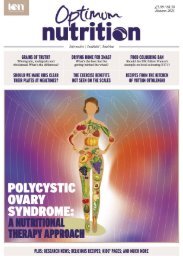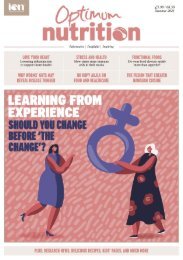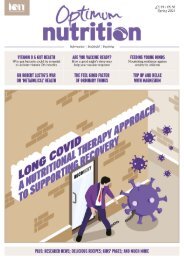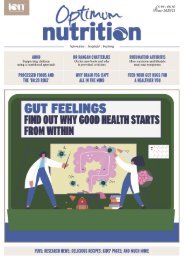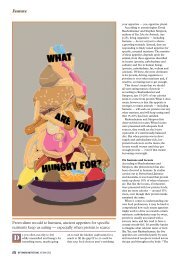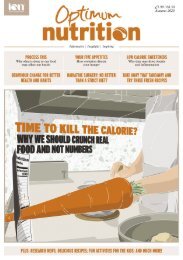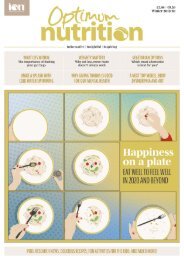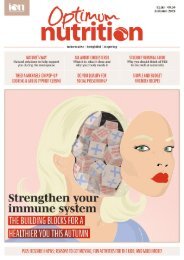Optimum Nutrition - Winter 2021 - PREVIEW
Why rethinking sugar and focusing on insulin resistance could stem an unseen epidemic | A 7-day energy supporting meal plan from registered nutritional therapist Catherine Jeans | Dr Megan Rossi answers questions on gut health and shares recipes from her new book Eat More, Live Well | Sustainable ways to retrain a sweet tooth | Plus research news, recipes, educational kids' pages and much more!
Why rethinking sugar and focusing on insulin resistance could stem an unseen epidemic | A 7-day energy supporting meal plan from registered nutritional therapist Catherine Jeans | Dr Megan Rossi answers questions on gut health and shares recipes from her new book Eat More, Live Well | Sustainable ways to retrain a sweet tooth | Plus research news, recipes, educational kids' pages and much more!
You also want an ePaper? Increase the reach of your titles
YUMPU automatically turns print PDFs into web optimized ePapers that Google loves.
Interview<br />
Image: Rrraven © 123rf.com<br />
because you’re incredibly thin and<br />
you’re not getting the nutrients you<br />
need, or you can be malnourished<br />
in the 21st century and be grossly<br />
overweight. Those two are just two sides<br />
of the same coin.”<br />
Gray, a broadcaster, writer and cook,<br />
has specialised in the history of food<br />
and dining in Britain for more than a<br />
decade, focusing on the 17th century<br />
onwards. You name it, she’s eaten it;<br />
from kangaroo brain cakes (“tasted<br />
a bit like spam, to be honest”) to an<br />
“epic” boar’s head during a Tudor<br />
feast. Since 2012, she’s been a regular<br />
panellist on BBC Radio 4’s The Kitchen<br />
Cabinet, and her latest book of the same<br />
name (fully titled The Kitchen Cabinet:<br />
A Year of Recipes, Flavours, Facts, &<br />
Stories for Food Lovers), which delves<br />
into Britain’s culinary past and present,<br />
was published in September <strong>2021</strong>.<br />
So she is perhaps well qualified to<br />
declare that insults thrown at British<br />
cuisine (or, perhaps, Britain’s lack of<br />
cuisine) are “total baloney”.<br />
“Britain has a really good food<br />
heritage both in terms of British dishes<br />
— roast meat, fish and chips, and pork<br />
pie — and our own food culture going<br />
backwards,” she says. “Yes, French<br />
cuisine was what ruled the roost in<br />
terms of the aristocracy for much of the<br />
past 500 years, but that was true right<br />
across the world — certainly among<br />
English speaking and European areas.”<br />
She does, however, believe that<br />
British food suffered after the Second<br />
World War — another reason why<br />
modelling your grand- or greatgrandmother’s<br />
diet mightn’t be the best<br />
approach.<br />
“I think a lot of people don’t realise<br />
that during the war, rationing was bad.<br />
But after the war it became worse,” she<br />
says. “And when you think about kids<br />
growing up, you’re eight when the war<br />
breaks up, but you’re probably married<br />
“I think a lot of people don’t<br />
realise that during the war,<br />
rationing was bad...but after<br />
the war, it became worse...”<br />
“We’ve both reduced the number of things we eat, but also in<br />
some ways we’ve got too much variety in others. You can get 20<br />
different varieties of pasta or five different types of ketchup...”<br />
with kids by the time rationing ends.<br />
That chance to learn, that transition<br />
of knowledge [about good food], isn’t<br />
really there.”<br />
It’s perhaps an ironic statement,<br />
considering that during her own<br />
teenage years, Gray survived on<br />
microwave meals. “My mother really<br />
couldn’t cook and my dad sort of<br />
could, but it was classic 1980’s family<br />
fare,” she says.<br />
This changed when the family moved<br />
to France during her A-levels, and Gray<br />
boarded with a French family. “It’s<br />
a bit of a cliché, but it was this total<br />
epiphany where I suddenly realised that<br />
food could be incredible.<br />
“My mother’s omelettes were always<br />
awful — you could bounce them off<br />
the ceiling. But I had one in France<br />
and was like ‘This isn’t an omelette’,<br />
because it was cooked in so much<br />
butter and unbelievably good.<br />
“I think it was at that point I realised<br />
if you’re going to eat three times a<br />
day, you should make it count.” At the<br />
University of Oxford, where she studied<br />
modern history, she was “the person<br />
who was roasting pheasant and making<br />
[her] own pasta”, despite a lack of<br />
cooking facilities.<br />
Yet after graduating, she still had no<br />
idea what she wanted to do and ended<br />
up “getting sacked from basically every<br />
job”.<br />
“I decided I would go back and do<br />
a masters [in historical archaeology]<br />
because I still loved history,” she says.<br />
“Then I left, got sacked a few more<br />
times and did a PhD. By this time I<br />
knew I wanted to study food and I<br />
knew I wanted to work with museums.<br />
The PhD allowed me to do those<br />
things.”<br />
“Greater choice…all an illusion”<br />
According to Gray, one of the biggest<br />
differences between historic and<br />
modern day diets is the variety of<br />
what we eat. With advances in trade,<br />
technology and travel, it can often<br />
appear like we have greater choice over<br />
our diets. But this, she says, is “all an<br />
illusion”.<br />
“There were 3,000 varieties of apples<br />
in the Victorian era, but today you walk<br />
into the average supermarket and get<br />
five, and they’re all enzyme treated.<br />
“We’ve both reduced the number<br />
of things that we eat, but also in some<br />
ways we’ve got too much variety in<br />
others. You can get 20 different varieties<br />
of pasta or five different types of tomato<br />
ketchup.”<br />
Certain vegetables have also<br />
disappeared from modern day diets<br />
completely; skirret (a root vegetable),<br />
scorzonera (similar to parsnip) and<br />
salsify (a root vegetable with an oysterlike<br />
taste).<br />
Jerusalem artichokes, which are<br />
beneficial for gut health, were also<br />
eaten habitually, and when it came to<br />
meat, every part of the animal would be<br />
eaten.<br />
Yet meat was “very much for the<br />
rich”. Historical cookbooks tend to<br />
draw attention to meat consumption,<br />
but this is only because the “food that<br />
gets the publicity is the stuff the rich<br />
ate”, she says.<br />
“We get this skewed idea that<br />
everybody ate loads of meat, very<br />
plainly done with some vegetables on<br />
Image: Torky © 123rf.com<br />
18 OPTIMUM NUTRITION | WINTER <strong>2021</strong>/22


